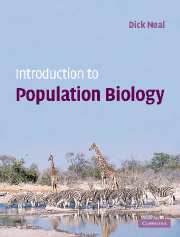Book contents
- Frontmatter
- Contents
- Preface
- Acknowledgements
- PART I Evolution by natural selection
- PART II Simple population growth models and their simulation
- PART III Population genetics and evolution
- PART IV Demography
- PART V Interactions between species, and the behaviour of individuals
- Chapter 17 Interspecific competition and amensalism
- Chapter 18 Predation
- Chapter 19 Animal behaviour, natural selection and altruistic traits
- Chapter 20 Sexual selection and mating systems
- Chapter 21 Epilogue
- Glossary
- Solutions to problems
- References
- Index
Chapter 17 - Interspecific competition and amensalism
- Frontmatter
- Contents
- Preface
- Acknowledgements
- PART I Evolution by natural selection
- PART II Simple population growth models and their simulation
- PART III Population genetics and evolution
- PART IV Demography
- PART V Interactions between species, and the behaviour of individuals
- Chapter 17 Interspecific competition and amensalism
- Chapter 18 Predation
- Chapter 19 Animal behaviour, natural selection and altruistic traits
- Chapter 20 Sexual selection and mating systems
- Chapter 21 Epilogue
- Glossary
- Solutions to problems
- References
- Index
Summary
The word ‘competition’ is used in everyday language, and so we all have a feeling for what it means. We tend to think of competition as an active process in which individuals are striving for a common goal, and trying to outdo each other so that there are winners and losers. In the biological world, individual organisms struggle to obtain the resources necessary for living, such as water, light and food, and we can think of this struggle as involving both intraspecific and interspecific competition. Darwin talked of these processes in terms of the ‘struggle for existence’ in the development of his theory of natural selection.
Defining competition
How do we define competition so that we can study the process in a rigorous way? Many ecologists prefer an operational definition that gives us a way of measuring whether competition is occurring or not. Following this logic, I will modify the definition of Emlen (1973) and define competition as follows: Competition occurs when two or more individuals or species experience depressed fitness (reduced r or K) attributable to their mutual presence in an area. Thus, in simple terms, competition is defined in terms of a mutual inhibition of growth. We have informally used this definition to define and measure intraspecific competition in Chapter 5 (section 5.1), and we will see that it is easy to extend the logistic growth model to include interspecific competition.
- Type
- Chapter
- Information
- Introduction to Population Biology , pp. 265 - 291Publisher: Cambridge University PressPrint publication year: 2003



